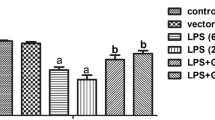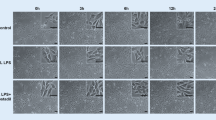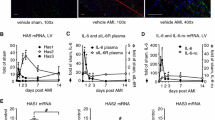Abstract
Bacterial lipopolysaccharide (LPS) is a known ligand of Toll-like receptor 4 (TLR4) which is expressed in cardiac fibroblasts (CF). Differentiation of CF to cardiac myofibroblasts (CMF) is induced by transforming growth factor-β1 (TGF-β1), increasing alpha-smooth muscle actin (α-SMA) expression. In endothelial cells, an antagonist effect between LPS-induced signaling and canonical TGF-β1 signaling was described; however, it has not been studied whether in CF and CMF the expression of α-SMA induced by TGF-β1 is antagonized by LPS and the mechanism involved. In adult rat CF and CMF, α-SMA, ERK1/2, Akt, NF-κβ, Smad3, and Smad7 protein levels were determined by western blot, TGF-β isoforms by ELISA, and α-SMA stress fibers by immunocytochemistry. CF and CMF secrete the three TGF-β isoforms, and the secretion levels of TGF-β2 was affected by LPS treatment. In CF, LPS treatment decreased the protein levels of α-SMA, and this effect was prevented by TAK-242 (TLR4 inhibitor) and LY294002 (Akt inhibitor), but not by BAY 11-7082 (NF-κβ inhibitor) and PD98059 (ERK1/2 inhibitor). TGF-β1 increased α-SMA protein levels in CF, and LPS prevented partially this effect. In addition, in CMF α-SMA protein levels were decreased by LPS treatment, which was abolished by TAK-242. Finally, in CF LPS decreased the p-Smad3 phosphorylation and increased the Smad7 protein levels. LPS treatment prevents the CF-to-CMF differentiation and reverses the CMF phenotype induced by TGF-β1, through decreasing p-Smad3 and increasing Smad7 protein levels.







Similar content being viewed by others
References
Abdalla, M., Goc, A., Segar, L., & Somanath, P. (2013). Response factor differentiation via myocardin and serum expression and myofibroblast Akt1 mediates alpha-smooth muscle actin. Journal of Biological Chemistry, 288(46), 33483–33493. PubMed PMID: 24106278. PubMed Central PMCID: PMC3829193.
Ayache, N., Boumediene, K., Mathy-Hartert, M., Reginster, J. Y., Henrotin, Y., & Pujol, J. P. (2002). Expression of TGF-betas and their receptors is differentially modulated by reactive oxygen species and nitric oxide in human articular chondrocytes. Osteoarthritis Cartilage, 10, 344–352. PubMed PMID: 12027535.
Bhattacharyya, S., Kelley, K., Melichian, D. S., Tamaki, Z., Fang, F., Su, Y., et al. (2013). Toll-like receptor 4 signaling augments transforming growth factor-β responses: a novel mechanism for maintaining and amplifying fibrosis in scleroderma. American Journal of Pathology, 182, 192–205.
Briest, W., Homagk, L., Rassler, B., Ziegelhöffer-Mihalovicová, B., Meier, H., Tannapfel, A., et al. (2004). Norepinephrine-induced changes in cardiac transforming growth factor-beta isoform expression pattern of female and male rats. Hypertension, 44(4), 410–418. PubMed PMID: 15326086.
Brown, R. D., Ambler, S. K., Mitchell, M. D., & Long, C. S. (2005). The cardiac fibroblast: therapeutic target in myocardial remodeling and failure. Annual Review of Pharmacology and Toxicology, 45, 657–687. PubMed PMID: 15822192.
Chen, T., Guo, J., Han, C., Yang, M., & Cao, X. (2009). Heat shock protein 70, released from heat-stressed tumor cells, initiates antitumor immunity by inducing tumor cell chemokine production and activating dendritic cells via TLR4 pathway. Journal of Immunology, 182(3), 1449–1459. PubMed PMID: 19155492.
Conery, A. R., Cao, Y., Thompson, E. A., Townsend, C. M., Jr., Ko, T. C., & Luo, K. (2004). Akt interacts directly with Smad3 to regulate the sensitivity to TGF-beta induced apoptosis. Nature Cell Biology, 6(4), 366–372. PubMed PMID: 15104092.
Copaja, M., Venegas, D., Aránguiz, P., Canales, J., Vivar, R., Catalán, M., et al. (2011). Simvastatin induces apoptosis by a Rho-dependent mechanism in cultured cardiac fibroblasts and myofibroblasts. Toxicology and Applied Pharmacology, 255(1), 57–64. PubMed PMID: 21651924.
Dabiri, G., Campaner, A., Morgan, J. R., & Van De Water, L. (2006). A TGF-beta1-dependent autocrine loop regulates the structure of focal adhesions in hypertrophic scar fibroblasts. Journal of Investigative Dermatology, 126(5), 963–970. PubMed PMID: 16498397.
Deten, A., Hölzl, A., Leicht, M., Barth, W., & Zimmer, H. G. (2001). Changes in extracellular matrix and in transforming growth factor beta isoforms after coronary artery ligation in rats. Journal of Molecular and Cellular Cardiology, 33, 1191–1207. PubMed PMID: 11444923.
Díaz-Araya, G., Vivar, R., Humeres, C., Boza, P., Bolívar, S., & Muñoz, C. (2015). Cardiac fibroblasts as sentinel cells in cardiac tissue: Receptors, signaling pathways and cellular functions. Pharmacological Research, 101, 30–40. PubMed PMID: 26151416.
Dobaczewski, M., Bujak, M., Li, N., Gonzalez-Quesada, C., Mendoza, L. H., Wang, X. F., et al. (2010). Smad3 signaling critically regulates fibroblast phenotype and function in healing myocardial infarction. Circulation Research, 107, 418–428. PubMed PMID: 20522804. PubMed Central PMCID: PMC2917472.
Dobaczewski, M., Gonzalez-Quesada, C., & Frangogiannis, N. G. (2010). The extracellular matrix as a modulator of the inflammatory and reparative response following myocardial infarction. Journal of Molecular and Cellular Cardiology, 48, 504–511. PubMed PMID: 19631653. PubMed Central PMCID: PMC2824059.
Dong, R. Q., Wang, Z. F., Zhao, C., Gu, H. R., Hu, Z. W., Xie, J., et al. (2015). Toll-like receptor 4 knockout protects against isoproterenol-induced cardiac fibrosis: The role of autophagy. Journal of Cardiovascular Pharmacology and Therapeutics, 20(1), 84–92. PubMed PMID: 24950765.
Ebisawa, T., Fukuchi, M., Murakami, G., Chiba, T., Tanaka, K., Imamura, T., et al. (2001). Smurf1 interacts with transforming growth factor-β type I receptor through Smad7 and induces receptor degradation. Journal of Biological Chemistry, 276, 12477–12480. PubMed PMID: 11278251.
Fan, D., Takawale, A., Lee, J., & Kassiri, Z. (2012). Cardiac fibroblasts, fibrosis and extracellular matrix remodeling in heart disease. Fibrogenesis Tissue Repair, 5(1), 15. PubMed PMID: 22943504. PubMed Central PMCID: PMC3464725.
Fang, H., Ang, B., Xu, X., Huang, X., Wu, Y., Sun, Y., et al. (2014). TLR4 is essential for dendritic cell activation and anti-tumor T-cell response enhancement by DAMPs released from chemically stressed cancer cells. Cellular and Molecular Immunology, 11(2), 150–159. PubMed PMID: 24362470. PubMed Central PMCID: PMC4003380.
Goodall, K. J., Poon, I. K., Phipps, S., & Hulett, M. D. (2014). Soluble heparan sulfate fragments generated by heparanase trigger the release of pro-inflammatory cytokines through TLR-4. PLoS One, 9(10), e109596.
Gronroos, E., Hellman, U., Heldin, C. H., & Ericsson, J. (2002). Control of Smad7 stability by competition between acetylation and ubiquitination. Molecular Cell, 10, 483–493. PubMed PMID: 12408818.
Hayashi, H., Abdollah, S., Qiu, Y., Cai, J., Xu, Y. Y., Grinnell, B. W., et al. (1997). The MAD-related protein Smad7 associates with the TGF-β receptor and functions as an antagonist of TGF-β signaling. Cell, 89, 1165–1173. PubMed PMID: 9215638.
He, Z., Gao, Y., Deng, Y., Li, W., Chen, Y., Xing, S., et al. (2012). Lipopolysaccharide induces lung fibroblast proliferation through Toll-like receptor 4 signaling and the phosphoinositide3-kinase-Akt pathway. PLoS ONE, 7(4), e35926. PubMed PMID: 22563417. PubMed Central PMCID: PMC3338545..
Kavsak, P., Rasmussen, R. K., Causing, C. G., Bonni, S., Zhu, H., Thomsen, G. H., et al. (2000). Smad7 binds to Smurf2 to form an E3 ubiquitin ligase that targets the TGF-β receptor for degradation. Molecular Cell, 6, 1365–1375. PubMed PMID: 11163210.
Kume, S., Haneda, M., Kanasaki, K., Sugimoto, T., Araki, S., Isshiki, K., et al. (2007). SIRT1 inhibits transforming growth factor β-induced apoptosis in glomerular mesangial cells via Smad7 deacetylation. Journal of Biological Chemistry, 282, 151–158. PubMed PMID: 17098745.
Lew, W. Y., Bayna, E., Dalle Molle, E., Contu, R., Condorelli, G., & Tang, T. (2014). Myocardial fibrosis induced by exposure to subclinical lipopolysaccharide is associated with decreased miR-29c and enhanced NOX2 expression in mice. PLoS ONE, 9(9), e107556R.D.
Li, P., Wang, D., Lucas, J., Oparil, S., Xing, D., Cao, X., et al. (2008). Atrial natriuretic peptide inhibits transforming growth factor beta-induced Smad signaling and myofibroblast transformation in mouse cardiac fibroblasts. Circulation Research, 102, 185–192. PubMed PMID: 17991884.
Yu, L., Wang, L., & Chen, S. (2010). Endogenous toll-like receptor ligands and their biological significance. Journal of Cellular Molecular Medicine, 14(11), 2592–2603. PMCID: PMC4373479.
Massagué, J. (1990). The transforming growth factor-beta family. Annual Review of Cell Biology, 6, 597–641. PubMed PMID: 2177343.
Okamura, Y., Watari, M., Jerud, E. S., Young, D. W., Ishizaka, S. T., Rose, J., et al. (2001). The extra domain A of fibronectin activates Toll-like receptor 4. Journal of Biological Chemistry, 276(13), 10229–10233. PubMed PMID: 11150311.
Peri, F., & Calabrese, V. (2014). Toll-like receptor 4 (TLR4) modulation by synthetic and natural compounds: an update. Journal of Medicinal Chemistry, 57(9), 3612–3622. PubMed PMID: 24188011. PubMed Central PMCID: PMC4040398.
Tavener, S. A., & Kubes, P. (2005). Is there a role for cardiomyocyte toll-like receptor 4 in endotoxemia? Trends in Cardiovascular Medicine, 15(5), 153–157. PubMed PMID: 16165010.
Remy, I., Montmarquette, A., & Michnick, S. W. (2004). PKB/Akt modulates TGF-beta signaling through a direct interaction with Smad3. Nature Cell Biology, 6(4), 358–365. PubMed PMID: 15048128.
Sandbo, N., Taurin, S., Yau, D. M., Kregel, S., Mitchell, R., & Dulin, N. O. (2007). Downregulation of smooth muscle alpha-actin expression by bacterial lipopolysaccharide. Cardiovascular Research, 74(2), 262–269. PubMed PMID: 17303098.
Serini, G., & Gabbiani, G. (1996). Modulation of alpha-smooth muscle actin expression in fibroblasts by transforming growth factor-beta isoforms: An in vivo and in vitro study. Wound Repair Regen, 4, 278–287. PubMed PMID: 17177825.
Stawowy, P., Goetze, S., Margeta, C., Fleck, E., & Graf, K. (2003). LPS regulate ERK1/2-dependent signaling in cardiac fibroblasts via PKC-mediated MKP-1 induction. Biochemical and Biophysical Research Communications, 303, 74–80. PubMed PMID: 12646169.
Sugiura, H., Ichikawa, T., Koarai, A., Yanagisawa, S., Minakata, Y., Matsunaga, K., et al. (2009). Activation of Toll-like receptor 3 augments myofibroblast differentiation. American Journal of Respiratory Cell and Molecular Biology, 40(6), 654–662. PubMed PMID: 18988918.
Tiede, K., Stöter, K., Petrik, C., Chen, W. B., Ungefroren, H., Kruse, M. L., et al. (2003). Angiotensin II AT (1)-receptor induces biglycan in neonatal cardiac fibroblasts via autocrine release of TGF-β in vitro. Cardiovascular Research, 60(3), 538–546.
Timmers, L., Sluijter, J. P., van Keulen, J. K., Hoefer, I. E., Nederhoff, M. G., Goumans, M. J., et al. (2008). Toll-like receptor 4 mediates maladaptive left ventricular remodeling and impairs cardiac function after myocardial infarction. Circulation Research, 102(2), 257–264. PubMed PMID: 18007026.
Tomasek, J., McRae, J., Owens, G., & Haaksma, C. (2005). Regulation of α-Smooth Muscle Actin Expression in Granulation Tissue Myofibroblasts Is Dependent on the Intronic CArG Element and the Transforming Growth Factor-β1 Control Element. American Journal of Pathology, 166(5), 1343–1351. PubMed PMID: 15855636. PubMed Central PMCID: PMC1606390.
Tomita, K., Takashina, M., Mizuno, N., Sakata, K., Hattori, K., Imura, J., et al. (2015). Cardiac fibroblasts: Contributory role in septic cardiac dysfunction. Journal of Surgical Research, 193(2), 874–887.
Turner, N. A., & Porter, K. E. (2013). Function and fate of myofibroblasts after myocardial infarction. Fibrogenesis Tissue Repair, 6(1), 5. PubMed PMID: 23448358. PubMed Central PMCID: PMC3599637.
Uematsu, S., & Akira, S. (2008). Toll-like receptors and innate inmunity. Handbook of Experimental Pharmacology, 183, 1–21. PubMed PMID: 18071652.
Vivar, R., Humeres, C., Varela, M., Ayala, P., Guzmán, N., Olmedo, I., et al. (2011). Cardiac fibroblast death by ischemia/reperfusion is partially inhibited by IGF-1 through both PI3 K/Akt and MEK-ERK pathways. Experimental and Molecular Pathology, 93(1), 1–7. PubMed PMID: 22537549.
Verstrepen, L., Bekaert, T., Chau, T. L., Tavernier, J., Chariot, A., & Beyaert, R. (2008). TLR-4, IL-1R and TNF-R signaling to NF-kappaβ: Variations on a common theme. Cellular and Molecular Life Sciences, 65, 2964–2978. PubMed PMID: 18535784.
Webber, J., Meran, S., Steadman, R., & Phillips, A. (2009). Hyaluronan orchestrates transforming growth factor-beta1-dependent maintenance of myofibroblast phenotype. Journal of Biological Chemistry, 284(14), 9083–9092. PubMed PMID: 19193641. PubMed Central PMCID: PMC2666557.
Weber, K. T. (2004). Fibrosis in hypertensive heart disease: Focus on cardiac fibroblasts. Journal of Hypertension, 22(1), 47–50. PubMed PMID: 15106793.
Yan, X., Lin, Z., Chen, F., Zhao, X., Chen, H., Ning, Y., et al. (2009). Human BAMBI cooperates with Smad7 to inhibit transforming growth factor-β signaling. Journal of Biological Chemistry, 284, 30097–30104. PubMed PMID: 19758997; PubMed Central PMCID: PMC2781564.
Yoshida, K., & Matsuzaki, K. (2012). Differential regulation of TGF-β/Smad signaling in hepatic stellate cells between acute and chronic liver injuries. Front Physiol, 3, 53. PubMed PMID: 22457652. PubMed Central PMCID: PMC3307138.
Zhang, S., Fei, T., Zhang, L., Zhang, R., Chen, F., Ning, Y., et al. (2007). Smad7 antagonizes transforming growth factor-β signaling in the nucleus by interfering with functional Smad-DNA complex formation. Molecular and Cellular Biology, 27, 4488–4499.
Zeuke, S., Ulmer, A. J., Kusumoto, S., Katus, H. A., & Heine, H. (2002). TLR4-mediated inflammatory activation of human coronary artery endothelial cells by LPS. Cardiovascular Research, 56(1), 126–134. PubMed PMID: 12237173.
Acknowledgements
This work was supported by FONDECYT (Grant 1130300 to G. Díaz-Araya) and CONICYT (Grant 63130233 to S Bolivar).
Author information
Authors and Affiliations
Corresponding author
Rights and permissions
About this article
Cite this article
Bolívar, S., Santana, R., Ayala, P. et al. Lipopolysaccharide Activates Toll-Like Receptor 4 and Prevents Cardiac Fibroblast-to-Myofibroblast Differentiation. Cardiovasc Toxicol 17, 458–470 (2017). https://doi.org/10.1007/s12012-017-9404-4
Published:
Issue Date:
DOI: https://doi.org/10.1007/s12012-017-9404-4




